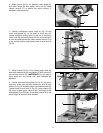
4
POWER CONNECTIONS
A separate electrical circuit should be used for your tools. This circuit should not be less than #12 wire and should be
protected with a 20 Amp time lag fuse. If an extension cord is used, use only 3-wire extension cords which have 3-
prong grounding type plugs and matching receptacle which will accept the tool’s plug. Before connecting the motor to
the power line, make sure the switch is in the “OFF” position and be sure that the electric current is of the same
characteristics as indicated on the tool. All line connections should make good contact. Running on low voltage will
damage the motor.
WARNING: DO NOT EXPOSE THE TOOL TO RAIN OR OPERATE THE TOOL IN DAMP LOCATIONS.
MOTOR SPECIFICATIONS
Your tool is wired for 230 volt, 60 HZ alternating current. Before connecting the tool to the power source, make sure
the switch is in the “OFF” position.
SINGLE PHASE MOTOR
The single phase motor is rated for 2 hp, 230 volt, 3450 RPM. Only operate the saw from a power
source that is within
+
10% of 230 volt nameplate rating.
THREE PHASE MOTOR
The three phase motor is rated at 2 hp, 200-230/460 volts, 3450 RPM.
Unless a special order is placed, the saw is shipped ready to run for 200-230 volts operation.
Should it be necessary to re-wire your saw for 460 volts, refer to Delta Instruction Manual for 24
volt LVC (Low Voltage Control) Magnetic Motor Control Systems and contact a qualified
electrician for proper procedures to convert the saw for 460 volt operation.
GROUNDING INSTRUCTIONS
WARNING: THIS TOOL MUST BE GROUNDED WHILE IN USE TO PROTECT THE OPERATOR FROM
ELECTRIC SHOCK.
2. Grounded, cord-connected tools intended for use on
a supply circuit having a nominal rating between 150 -
250 volts, inclusive:
This tool is intended for use on a circuit that has an outlet
that looks like the one illustrated in Fig. C. The tool has
a grounding plug that looks like the plug illustrated in Fig.
C. Make sure the tool is connected to an outlet having
the same configuration as the plug. No adapter is
available or should be used with this tool. If the tool
must be reconnected for use on a different type of
electric circuit, the reconnection should be made by
qualified service personnel; and after reconnection, the
tool should comply with all local codes and ordinances.
WARNING: IN ALL CASES, MAKE CERTAIN THE
RECEPTACLE IN QUESTION IS PROPERLY
GROUNDED. IF YOU ARE NOT SURE HAVE A
QUALIFIED ELECTRICIAN CHECK THE RECEPTACLE.
1. All grounded, cord-connected tools:
In the event of a malfunction or breakdown, grounding
provides a path of least resistance for electric current to
reduce the risk of electric shock. This tool is equipped with
an electric cord having an equipment-grounding
conductor and a grounding plug. The plug must be
plugged into a matching outlet that is properly installed
and grounded in accordance with all local codes and
ordinances.
Do not modify the plug provided - if it will not fit the outlet,
have the proper outlet installed by a qualified electrician.
Improper connection of the equipment-grounding
conductor can result in risk of electric shock. The
conductor with insulation having an outer surface that is
green with or without yellow stripes is the equipment-
grounding conductor. If repair or replacement of the
electric cord or plug is necessary, do not connect the
equipment-grounding conductor to a live terminal.
Check with a qualified electrician or service personnel if
the grounding instructions are not completely understood,
or if in doubt as to whether the tool is properly grounded.
Use only 3-wire extension cords that have 3-prong
grounding type plugs and matching 3-conductor
receptacles that accept the tool’s plug, as shown in Fig. C.
Repair or replace damaged or worn cord immediately.
Fig. C
GROUNDED OUTLET BOX
CURRENT CARRYING
PRONGS
GROUND PRONG


















